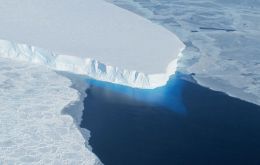MercoPress. South Atlantic News Agency
Tag: West Antarctic Ice Sheet
-
Saturday, December 30th 2023 - 07:04 UTC
Octopus DNA helps to discover evolution of the West Antarctic Ice Sheet collapse

Scientists, including from British Antarctic Survey, have used octopus DNA to discover that the West Antarctic Ice Sheet (WAIS) likely collapsed during the Last Interglacial period around 120,000 years ago – when the global temperatures were similar to today.
-
Thursday, June 14th 2018 - 07:24 UTC
Antarctica ice sheet melting faster than expected, adding 0.6mm to sea level every year

The Antarctic ice sheet has lost more than 2,500 billion tons of ice in the past 25 years and nearly half of that has happened since 2012. An international team of polar scientists found that melting in Antarctica has jumped sharply from an average of 76 billion tons per year prior to 2012, to around 219 billion tones each year between 2012 and 2017.
-
Thursday, June 12th 2014 - 07:32 UTC
Researchers find major West Antarctic glacier melting from geothermal sources

Thwaites Glacier, the large, rapidly changing outlet of the West Antarctic Ice Sheet, is not only being eroded by the ocean, it's being melted from below by geothermal heat, researchers at the Institute for Geophysics at The University of Texas at Austin (UTIG) report in the current edition of the Proceedings of the National Academy of Sciences.
-
Wednesday, May 28th 2014 - 22:04 UTC
Antarctica ice sheet melting episodes have occurred over the last 14.000 years, say scientists

A new study has found that the Antarctic Ice Sheet began melting about 5,000 years earlier than previously thought coming out of the last ice age, and that shrinkage of the vast ice sheet accelerated during eight distinct episodes, causing rapid sea level rise.
-
Thursday, October 11th 2012 - 07:56 UTC
British team to drill sub-glacial Antarctic lake and define limits of life in the planet

After 16 years of planning the countdown is on for one of the most ambitious scientific missions to Antarctica. In October a 12-man team of British scientists, engineers and support staff will make the 16.000 km journey from the UK to go deep into the heart of the frozen continent to collect samples of water and sediments from an ancient lake buried beneath three kilometers of ice.
